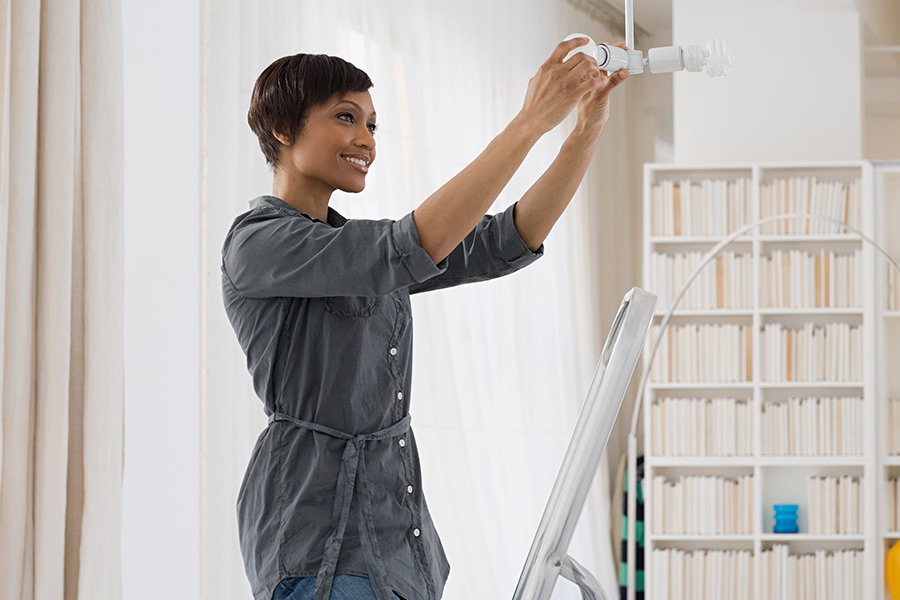
Are you tired of seeing those skyrocketing electricity bills or feeling guilty about your carbon footprint? Let’s explore some practical and effective strategies to enhance the energy efficiency of your humble abode. By implementing these proven tips, you will not only reduce your utility bills but also contribute to a greener and more sustainable world.
Brighten up your living space while saving energy by maximizing natural light. Open those curtains, pull up those blinds, and let the sun work its magic. Not only will you save electricity, but natural light also boosts your mood and makes your home feel cozier.
Invest in a smart thermostat to optimize your home’s energy usage. Set it to adjust temperatures automatically when you’re away or asleep. These nifty gadgets learn your preferences over time and help you cut down on unnecessary heating or cooling, all while ensuring comfort when you’re home.
When the time comes to replace old appliances, opt for energy-efficient models. Look for the Energy Star label, which indicates that the appliance meets strict energy efficiency standards. These appliances not only reduce your energy consumption but also help you save money in the long run.
Swap out those energy-hungry incandescent bulbs with LED lights. LEDs are highly energy-efficient, last longer, and provide better lighting quality. It’s a win-win situation for both the environment and your wallet.
Did you know that electronics and appliances continue to consume power even when they’re not in use? It’s called “vampire power” or “standby power.” Combat this sneaky energy drain by unplugging devices or using power strips with switches to completely cut off power when not needed.
Don’t let your hard-earned money escape through poorly insulated walls and roofs. Proper insulation helps maintain a comfortable temperature indoors, reducing the need for excessive heating or cooling. Insulate your home and watch your energy bills shrink!
When weather permits, open up those windows and let nature cool your home. A gentle breeze not only freshens up the indoor air but also reduces the reliance on energy-hungry air conditioning systems.
Believe it or not, your landscaping choices can impact your home’s energy efficiency. Planting trees strategically to provide shade can keep your home cool during summers, while allowing sunlight to enter during winters. Plus, it adds beauty to your surroundings!
Conserving water is not only good for the environment but also helps you save on water heating costs. Install low-flow showerheads and faucets, fix leaks promptly, and consider collecting rainwater for your garden. Small steps like these can make a big difference.
By implementing these energy-efficient tips, you’ll not only reduce your carbon footprint but also save some serious dough. Remember, every small effort counts, and together we can create a greener, more sustainable world.
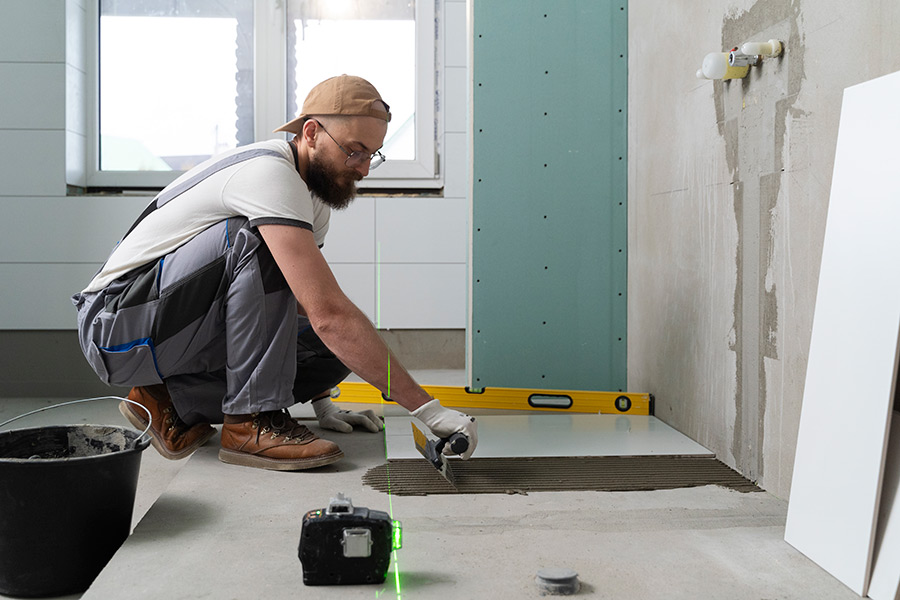
A bathroom remodel can be a transformative project that enhances the functionality and aesthetics of your home. By understanding the various stages, challenges, and considerations involved, you can approach the process with confidence. Collaborating with experienced professionals, planning meticulously, and maintaining open communication will ensure a successful and satisfying bathroom remodeling experience. However, it’s crucial to be prepared for the process and understand what to expect. Here are some insights into what you can anticipate during a bathroom remodel.
The first step in any successful bathroom remodel is careful planning and design. This phase involves evaluating your needs, setting a budget, and determining the scope of the project. Collaborating with an experienced contractor or designer is essential during this stage, as they can help you create a functional and aesthetically pleasing design that aligns with your vision.
Once the design is finalized, the next phase is demolition and preparation. This involves removing existing fixtures, such as the bathtub, sink, toilet, and tiles. Expect some dust, noise, and disruption during this process. It’s crucial to protect surrounding areas from damage and to disconnect any electrical or plumbing connections safely.
After demolition, the construction phase begins. This includes installing new plumbing, electrical work, drywall, flooring, and cabinetry. Depending on the complexity of the project, this stage can take several weeks to complete. It’s important to have a clear timeline and regular communication with your contractor to stay informed about the progress.
During a bathroom remodel, it’s not uncommon to encounter unexpected challenges or issues that were not apparent during the planning phase. These can range from plumbing or electrical complications to structural problems. It’s essential to remain flexible and allow some leeway in your budget and timeline to accommodate any unforeseen circumstances. Working closely with your contractor and maintaining open communication will help address these challenges effectively.
It’s important to acknowledge that a bathroom remodel can cause temporary inconvenience in your daily life. Depending on the scope of the project, you may need to find alternative bathroom arrangements during the construction phase. It’s a good idea to plan this in advance, whether it’s using a different bathroom in your home or making arrangements with neighbors or friends. Understanding and accepting this temporary inconvenience will help you manage your expectations throughout the remodel.
As the construction nears completion, it’s time to focus on the finishing touches that will give your bathroom its final polish. This involves painting, tiling, installing fixtures, and adding accessories like mirrors, towel racks, and lighting. Take this opportunity to pay attention to detail and ensure that everything is in place to create a cohesive and beautiful space.
Once the remodeling work is finished, it’s time to inspect the newly renovated bathroom and address any remaining issues or touch-ups. Your contractor will guide you through this final walkthrough, and upon your satisfaction, they will conduct a thorough clean-up, leaving your bathroom ready to be enjoyed.
It’s important to establish a regular maintenance routine to keep your newly renovated space in top condition. This includes cleaning and inspecting fixtures, checking for any signs of leaks or damage, and addressing issues promptly. Regular maintenance will not only prolong the life of your bathroom but also prevent any costly repairs down the line.

Summer is almost here, and while we all love the warmer weather and sunshine, it’s important to make sure our homes are ready for the heat. One of the best ways to prepare for summertime is to check your home’s insulation. Proper insulation can help keep your home cool, comfortable, and energy-efficient during the hot summer months.
Insulation acts as a barrier to heat transfer, helping to keep warm air inside during the winter and cool air inside during the summer. This means that properly insulated homes require less energy to heat and cool, which can translate into significant savings on your energy bills. In addition, insulation can help improve indoor air quality by reducing the amount of outdoor pollutants that enter your home.
Before the heat of summer sets in, it’s a good idea to check your home’s insulation to make sure it’s in good shape. Here are some tips for checking your insulation:
Check the Attic: The attic is one of the most important areas to check when it comes to insulation. You should have at least 12 inches of insulation in your attic, and it should be evenly distributed. Look for any gaps or areas where the insulation may have settled, which could indicate that it needs to be replaced or repositioned.
Check the Walls: If you have access to the walls, check for insulation there as well. You should have at least R-13 insulation in the walls. If you’re not sure what type of insulation you have, you can remove a small piece of the drywall to check.
Check the Windows and Doors: Windows and doors are notorious for letting in drafts and allowing heat to escape. Check for any gaps or cracks around the frames, and consider adding weatherstripping or caulking to seal them up.
Check the Floors: If you have a crawl space under your home, check for insulation there as well. You should have at least R-19 insulation under the floors.
If you find that your home’s insulation is lacking, there are a few things you can do to improve it:
Add Insulation: The easiest way to improve your home’s insulation is to add more of it. You can purchase rolls or batts of insulation at your local home improvement store, or hire a professional to blow in loose-fill insulation.
Seal Up Gaps and Cracks: Use weatherstripping or caulking to seal up any gaps or cracks around windows, doors, and other areas where air can escape.
Upgrade Windows and Doors: If your windows and doors are old or leaky, consider upgrading to newer, more energy-efficient models.
Consider a Home Energy Audit: A home energy audit can help you identify areas of your home that may be wasting energy, and provide recommendations for how to improve your insulation and overall energy efficiency.
Preparing your home for summertime by checking your insulation is a smart and cost-effective way to keep your home cool, comfortable, and energy-efficient. By taking the time to check and improve your insulation now, you can enjoy a more comfortable summer and potentially save money on your energy bills.
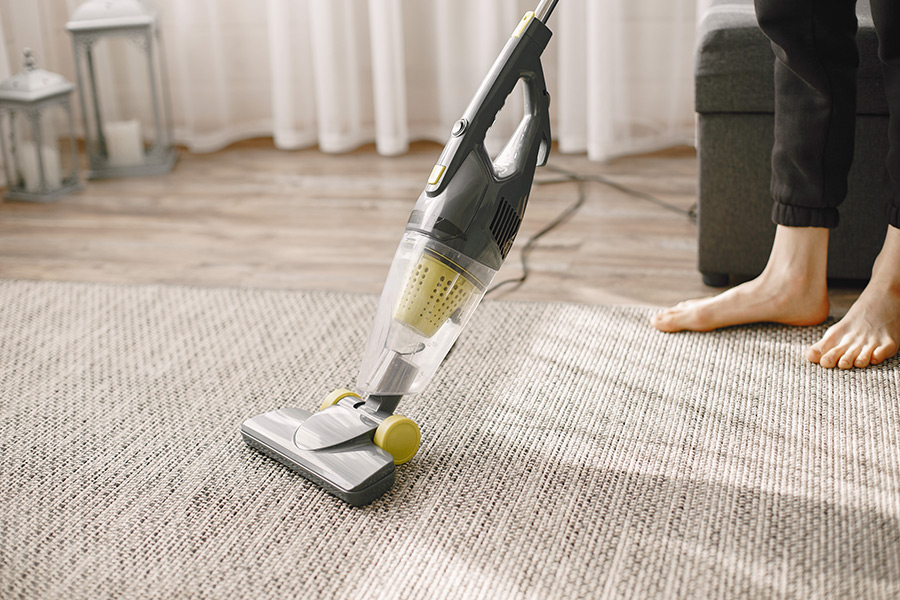
As soon as the first hint of spring arrives, we’re busy making our to-do list, checking it twice, and stocking up on all the essentials for a complete floor-to-ceiling spring clean. One of the most vital tools you’ll use during this yearly endeavor is your handy dandy vacuum cleaner. The vacuum is an amazing invention that helps keep your home free of dust and debris. That being said, you should avoid cleaning up certain things with your upright or cordless vacuum. Vacuums can be damaged by some items, requiring costly repairs or making it useless, while possibly clogging their filters leaving more of a mess behind. So stop and question if the mess you are about to clean up is safe to use your vacuum on.
In order to get rid of broken glass as quickly as possible, you might be tempted to vacuum it up off the floor. In reality, that isn’t the best idea. Sharp edged glass shards can damage the vacuum’s bag or internal components, causing damage and costly repairs. Instead, carefully sweep the mess into a pile and pick it up with a dustpan. If you’d like to run a vacuum afterwards to insure tiny slivers aren’t left behind, that’s fine.
The vacuum motor can burn out if fine powders or particles of soil and coffee grounds get into it. Other similar items that aren’t advisable to vacuum up are sawdust and makeup. Even if the particles do not affect the motor, they may just be released right back into the air, negatively impacting the air quality in the room or they could get stuck in the hose or inside the machine, where they could potentially cause mold to grow.
The best thing to do when vacuuming up liquids is not to do it with a standard vacuum cleaner. It is not recommended to vacuum liquids with a standard household vacuum because liquids can become trapped inside the machine, instead of reaching the dirt cup or bag. Getting liquid inside the appliance can cause it to malfunction, and it may even invite mold growth. Yet more dangerous is the potential for electrocution. Always keep vacuums and other electrical appliances away from liquids. Wet mess cleanup should only be done with a shopvac. Just remember to rinse out the bucket and hose and dry thoroughly before storing.
If you or your pet sheds a lot, a pet hair vacuum is great for keeping the house clean. Even so, a vacuum should not be used to clean up large clumps of hair or fur. You will have a hard time cleaning out a clog if you try to pull too much hair at one time. Before you start vacuuming, pick up any hair clumps on the floor with a broom and dustpan before vacuuming up big clumps of hair. You will need to clean out your vacuum’s brush roll as well.
Using your vacuum to suck up ash from your fireplace isn’t the best idea. The tiny particles you try to collect with your vacuum will probably blow right back out into the air. In addition, vacuuming up ashes too early may pose a fire risk because ashes can hold heat for a long time after a fire has been extinguished. If you insist on vacuuming up ashes, let them cool for at least 36 hours before you do so and use a dustpan and handheld brush to pick up most of the mess first. This way you’re only vacuuming up a minimal amount of problem causing particles and putting less strain on your favorite cleaning tool.
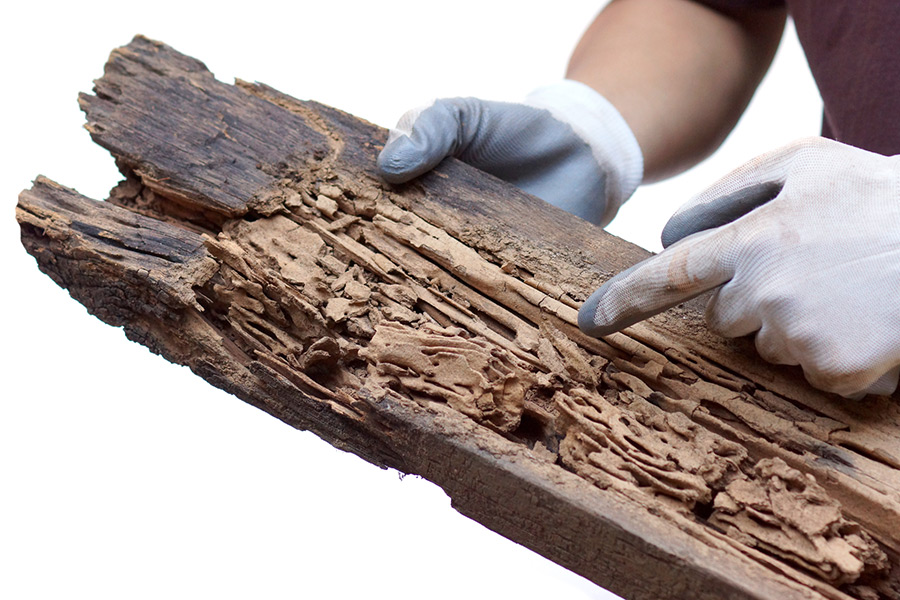
Discovering a pest problem in your home can be devastating. However, what may be worse is having one and not knowing about it. When it comes to protecting your home and family, you can never be too careful, especially when it comes to termite infestation.
These evasive, unwanted house guests can easily cause billions in damages and slowly eat you out of the house and home – literally. Sadly, termites can be difficult to spot, and the cost of repairs may not be covered by insurance.
To safeguard against termites, you must be vigilant; search for signs of a termite presence in your home and stop the infestation before it’s too late. Here are some early warning signs of a termite infestation.
Some of the most common indicators are mud tubes. Certain species of termites need to stay moist. Subterranean termites create mud tubes to get around. Termites use their saliva to glue these tunnels together from moist soil to get from their colony to their food source. Homeowners may see the pencil-width mud tubes spreading out like veins on their home’s foundation or on hard surfaces around your property. It’s important to walk around your home with a sharp eye for signs of these mud tubes.
Like many pests, the easiest way to discover an infestation is by finding droppings, also known as “frass”. Drywood termites may leave behind small, wood-colored pellets. You can find these deposits anywhere. As they tunnel, termites like to keep their areas clean. To do that, they must remove their excrement from their path. Their droppings can often have the appearance of coffee grounds or sawdust.
Termites tend to target locations like windows and door frames, where wood is exposed and easy to access. As termites begin to eat through the wood, it may cause your windows and door frames to warp, making it difficult to open or close them properly.
Besides stuck windows or doors, damage from termites may also result in other types of structural problems in your home, such as crumbling baseboards or sagging floors and ceilings.
Termites leave behind tiny pin holes while feeding on cardboard and wood paneling underneath the surface of your walls. An unusual appearance on painted or wallpapered surfaces can also be an early sign of termites. If you look carefully, you can see signs of termite damage underneath, such as:
You may spot swarmers, winged adult termites that fly away in groups. That is a sign that an infestation could be near. Swarmers are not good flyers; they often shed their wings and crawl away. A pile of discarded wings is another clue that termites are present.
There are ways to prevent a termite infestation before it happens. Make sure there is no wood-to-ground contact in your yard. If you have wood steps, a concrete block at the bottom of the steps may confuse the termites enough to keep them from climbing to wooden steps.
If you’re building a deck use pressure-treated wood, which is more resistant to termites though not termite-proof. And of course, follow good home maintenance and building procedures. Moisture-damaged wood is more appealing to termites, so keep an eye out for leaking gutters and other moisture problems.
And if you do find an infestation, don’t panic. Termites won’t eat your house overnight; in fact, it would take five months for 60,000 termites to eat one foot of a two-by-four piece of lumber.

In summer, there is nothing more relaxing than spending time at home with your family. The sun is shining, which means it’s time to get started on those projects you’ve been putting off for months. Now that summer is almost here, you’ll want to get started on home improvement projects and take advantage of the nice weather and tackle these tasks before you have to deal with them when it gets too hot.
During the summertime, grills get a lot of use, from quick meals during the week to holiday cookouts and all the outdoor entertaining that summertime brings. As a precaution, make sure that you thoroughly clean your grill at the start of the season, and make sure that you burn off grease and remove food residue.
If you enjoy spending time outside, whether you relax on the deck or patio with friends or just lay out on a lawn chair reading a good book, spending time outside is special. The deck or patio should be in tip-top shape before summer kicks in, so do everything you can to keep it clean – whether you wash it, check for cracks, or simply hose it down.
Put aside a weekend to clean your windows early in the summer to ensure that they are sparkling clean. Our window areas are notorious for collecting dirt, grime and dust. Take care of these head on with a thorough cleaning before the summer starts, so you can relax and enjoy your evening breeze while preventing seasonal allergies. Choose a cloudy day to prevent streaks from drying too quickly.
During the summer, it is essential that you have access to a functioning air conditioner. This will prevent you from experiencing a cooling catastrophe. Before those ultra-high temperatures hit, make sure your air conditioner is functioning to its best ability. Preparing in advance will help you prevent an A/C catastrophe, whether it’s cleaning out the filter or performing a thorough A/C function test. Maybe take this time to install a “smart” thermostat in your home. These amazing devices allow you to adjust your home’s temperature from your smartphone, so it’s always just right when you get home. With smart thermostats, you can automate your home’s temperature on a timer, or even set it up from your smartphone. Aside from being immensely convenient, it’s also an excellent way to save money and help reduce your carbon footprint.

Home electronics and electrical devices can get dirty sooner than you may expect. Dust can quickly gather on televisions and other screens and surfaces, while fingers can leave oils, bacteria and smudges on keyboards, remote controls, smartphones and more. It’s important to keep home electronics clean, especially during cold and flu season. It’s easy to learn how to clean home electronics and ensure that your devices look better and last longer.
Even though you don’t touch your computer or laptop screen as often as your cell phone, they are still susceptible to collecting fingerprints and dust. To clean your monitors, turn them off, then add some dish soap to warm water. To remove any lingering drops of moisture and eliminate streaks, wipe down the screens with a microfiber cloth dipped in the mix and squeezed out the excess water. Rinse the cloth with clean water and wipe down again.
Start disinfecting your cellular device daily. The fact that we touch our phones and even put our phones to our faces makes it easy to spread bacteria. Every day, phones are placed on many different surfaces, making it easy for bacteria to spread. You should sanitize your phone and case on a daily basis in order to prevent germs from spreading.
Things that are communal in your home are most likely germ covered. Modems and routers are often tucked away in a corner and are often coated with dust and pet hair, and we don’t even think about them until they stop working. Those that live on the floor are often covered with pet hair and dust. The vents on these boxes help release the heat generated by them, just as they do on computer towers. To keep your router or modem working properly, dust it regularly and wipe it down with a dry microfiber cloth at least once a month.
Due to the frequency with which this gear is touched, it is important to clean it regularly to prevent germs from spreading. To clean the keyboard, disconnect it from the power source first. The dust and debris between the keys should be cleaned with compressed air. To clean the keys, lightly dab rubbing alcohol onto a cotton swab, and move the cotton swab in a circular motion, before drying them off with a microfiber cloth. You should clean these touchpoints at least once a week. If you are ill, you should clean them every time you use them.
Remember to check the manufacturer’s instructions before cleaning electronics in your house to make sure that you don’t damage them. Cleaning hack:Turn off any of your electronics before cleaning them. It’s easier to see dirt and smudges when the screen is off, and you’ll be unlikely to push any buttons by accident.
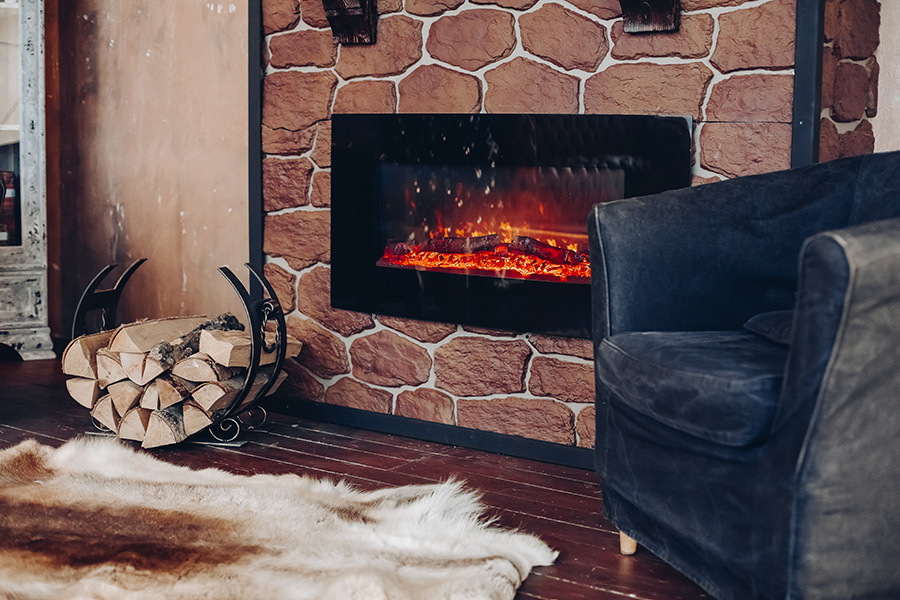
Many people love the cozy and soothing ambiance that fireplaces provide, whether it’s the crackling sound of burning wood or the mesmerizing flicker of flames.
Traditional wood-burning fireplaces are common in older homes, but new construction houses often have gas or electric fireplaces instead, since they are less costly, easier to install, and require less maintenance. It’s not uncommon for homeowners to convert wood-burning fireplaces into gas or electric fireplaces. These changes can increase the value of a house and make it more appealing to buyers. Be sure to consult with a professional when deciding whether to install a gas fireplace or electric fireplace.
There is a reputation for gas-burning fireplaces as being cleaner and more convenient than traditional wood-burning fireplaces, in which homeowners have to collect and chop wood, handle ash and soot removal, and deal with creosote buildup safety issues. Heat fills a room instantly after a single push of a button with a gas-burning fireplace.
There are three types of gas fireplaces: vented, ventless, and insert. There is a gas line or propane supply required for all types of gas fireplaces. In addition to providing adequate heat, vented gas fireplaces also offer aesthetics beyond heat. Finally, natural gas fireplace inserts come in a wide range of sizes and styles and can come with features such as thermostats and remote controls. Secondly, ventless gas fireplaces are attractive and provide adequate heat, but can trigger allergies and asthma symptoms.
A modern and decorative indoor electric fireplace is a heating appliance that uses electricity to generate heat and can be used in almost any room. Electric indoor fireplaces offer a warm and welcoming atmosphere. Depending on their size and style, they can be mounted on the wall, recessed into the wall, or even built into furniture. Although they do not use actual fire, they produce a realistic flame and often have features such as adjustable heat settings, thermostat controls, and a remote control for ease of operation.
The electric fireplace requires a standard electric outlet to function, but homeowners may need to run a dedicated circuit or a new line. The outlet should be 110v or 220v, depending on the model. The installation of an electric fireplace can be as straightforward as plugging it in, but it may also involve adding an outlet next to the fireplace, cutting out an area for it, wiring the unit, and installing a mantel.
Many users choose a fireplace based on the flames that mimic a wood-burning fireplace. Gas fireplaces have an actual flame that emits heat, unlike electric fireplaces. While electric fireplaces project images of burning logs and may have sound effects that mimic crackling fires, they tend to appear more artificial. They do, however, have controllable flames and temperatures, which is a good option for those living in warm climates.
In the past, electric fireplaces looked fake, but modern technology has made them look much more realistic. Water vapor and LED lights produce a flame effect that looks like a real fire without the mess, odor, or safety concerns of gas or wood fire features, making electric fireplaces a hot trend.
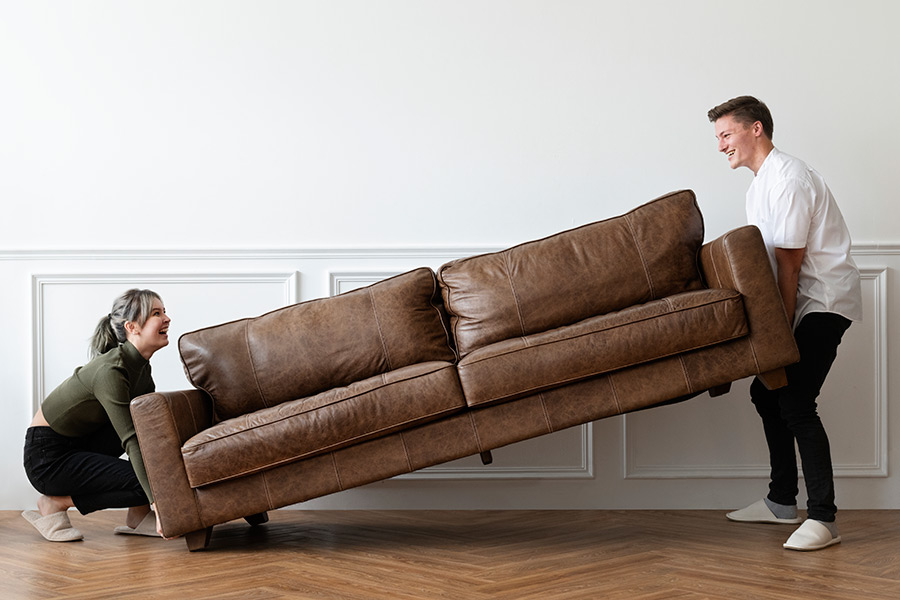
So, you just bought a new couch…and it’s perfect. It’s just the right color, just the right size, just the right amount of comfy…it magically transformed your living space in a way you never thought was possible. However, you are now faced with a daunting new task: getting rid of your old couch. Yes, you could just dump it in the trash, and let it go to the landfill. But you just know you’d feel like a terrible environmentalist contributing to landfill waste. So, maybe you want to consider some more eco-friendly alternatives. What might those be, you wonder? Well, we’re glad you asked.
Selling locally is one of the cheapest, easiest ways to get rid of old, good-condition furniture. That way, you know for sure it will be repurposed and put to use instead of sitting in a dump somewhere. And, unlike the alternative, selling your couch might make you a bit of money.
You can list your couch online (on Facebook Marketplace or Craigslist, for example), or on local online yard sale groups. If you decide to go this route, there are just a few things to be mindful of. Watch out for scammers online and ignore any offers or requests that sound suspicious. Also, make sure to clean your couch and try to remove any stains before you arrange to sell it. If there are spots that absolutely will not come out, or if there are any other notable imperfections, make sure to document them in your listing so your potential buyers aren’t surprised when they see your couch in person for the first time.
You might be able to give your couch to someone you know, such as a friend or family member, rather than disposing of it. Some older, but still perfectly usable, furniture would greatly benefit a household in need. It might be possible to find someone who needs a couch for the home they’re moving into, or to replace an existing couch in their home. You get rid of your old sofa, they get a new one… it’s like the furniture circle of life.
Or, donating to a charity that accepts furniture is a great way to make a community impact. Check to see if your local donation center is able to accept your old couch. There may even be a possibility that they can pick it up from your house. The other great thing about donating? You can mark it as a deduction on your tax returns. See, everybody wins.
Your sofa may need major repairs if it’s in less-than-optimal condition. In some cases, it might just be time to let it go. You can deconstruct your couch and take its parts to a recycling center where they can be repurposed there. Fair warning: disassembling your old furniture might not be an easy task. But if you truly have your heart set on keeping that couch out of a landfill, you might just have to resort to this.
First, you will want to take the cushions off the couch and set them to the side. Then, go in with either a box cutter or a staple remover, and remove the upholstery from the couch. Take off the chair legs next using a screwdriver. If there are no visible screws, you might just have to saw the legs off. Once all of this is done, you will be left with the basic frame of the couch. From there, the cushions, fabric, and wooden pieces can all be taken to a recycling center. The metal pieces can go to a scrap yard.

It is probably hard to know where to start when it comes to buying a new refrigerator, especially if you have never done it before. Luckily, we’ve got you covered with some of the most important things you need to know. Read on to stay knowledgeable as you navigate the fridge market.
If you are looking for options, it is important to know the difference between freestanding refrigerators and built-in refrigerators before you begin shopping. A freestanding refrigerator is easy to install because it is simply plugged in and pushed into the cabinetry. Built-in refrigerators are, on the other hand, built into your cabinetry. With paneling, they can be matched to the cabinets in the room and fit seamlessly into the space. In addition to freestanding fridges, they are shallow with no front protruding past the counter, giving it a more customized appearance.
It is often overlooked how much space refrigerators take up. Not only do they take up space on their own, but you will need additional space behind them so that they can breathe and vent heat. These requirements should be included with the refrigerator’s information. Ensure that the appliance will fit through the doorway and around any islands or obstacles in your house. Always be safe and leave your refrigerator with some wiggle room.
The doors must open to allow you good access to all the stuff inside the fridge if you choose anything other than a French-door style. Specify which way you want the doors to open if they are reversible. If the doors only open up one way, you will have to crane your neck to get in. Whichever refrigerator model you like, you will need to decide what suits you and your space.
Look at your refrigerator and list all of the things you like about it, or what you would like to see added to it. You might not be able to live without an ice maker, but most European models lack that feature. Your wish list should be included in the model you like. Of course, the more bells and whistles you want, the more you will have to spend. Storage space can also differ between brands and orientations. While most new refrigerators are going to be more energy-efficient than the ones available a decade ago, you should still look for an EPA Energy Star rating to ensure you will be saving money on your energy bill.
Like what you see? Make it Yours!